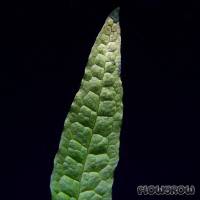



Microsorum pteropus, or Java fern, has long been used in the aquarium hobby. Its cultivation is very easy, it is a decorative plant and it is also readily available in trade.
During the last years, increasingly more different forms of the originally quite large and broad-leaved Java fern have been imported. One of the most attractive forms is Microsorum pteropus 'Philippine'. Its relatively small, fresh green leaves are pronouncedly structured and have a "hammered" surface, which makes this a very attractive plant. In aquaristics, M. pteropus 'Philippine' was introduced by the Danish aquatic plant nursery Tropica.
Even though the various Java fern varietys and cultivars look quite differently, their demands regarding water, fertiliser and light are more or less identical. Microsorum pteropus 'Philippine', however, is an exception. Even though it is not a difficult-to-care-for plant it has certain demands. First and foremost, it does not do too well in very soft, acidic water, which is quite plausible, as it often even grows in brackish water habitats on the island of Panay. If the water parameters in the aquarium don't befit it, the leaves of Microsorum pteropus 'Philippine' tend to develop black spots and holes. Very clearly, this is not a Java fern you want to put into a Tonina/Eriocaulon tank. A total hardness of 10° dGH and over and a pH of 6.6 or more can be considered a reference value.
The conditions in its natural habitats make M. pteropus 'Philippine' an excellent plant for brackish aquariums.
If hardness and pH are considered, Microsorum pteropus 'Philippine' is quite easy to cultivate, too. This variety grows well under low light, a low CO2 level and minimal fertilisation. Under more light, with the addition of CO2 and fertiliser, it turns bright green, grows far more rapidly and gets quite robust.
Like other Java fern varieties, 'Philippine' is also best used as an epiphyte on driftwood or rocks. It can also be placed on the ground, given that its rhizome isn't covered or planted in the substrate.
For propagation, the rhizome is cut into parts, or daugter plants growing on the leaves are separated from the mother plant and cultivated independently (please see the description of Microsorum pteropus).
The adult, fully grown plant can reach 30 cm in height or more, thus its place in the tank should be carefully selected or cut off overgrown leaves on a continuous basis. Removing adventitious plants on the leaves on a regular basis adds to the overall appearance of the plant group.
<a href="https://www.flowgrow.de/db/aquaticplants/microsorum-pteropus-philippine" target="_blank"><img alt="Microsorum pteropus 'Philippine'" title="Microsorum pteropus 'Philippine'" src="https://www.flowgrow.de/db/widget/aquaticplants/microsorum-pteropus-philippine" /></a>
[url=https://www.flowgrow.de/db/aquaticplants/microsorum-pteropus-philippine][img]https://www.flowgrow.de/db/widget/aquaticplants/microsorum-pteropus-philippine[/img][/url]
[widget=aquaticplants/microsorum-pteropus-philippine]Microsorum pteropus 'Philippine'[/widget]